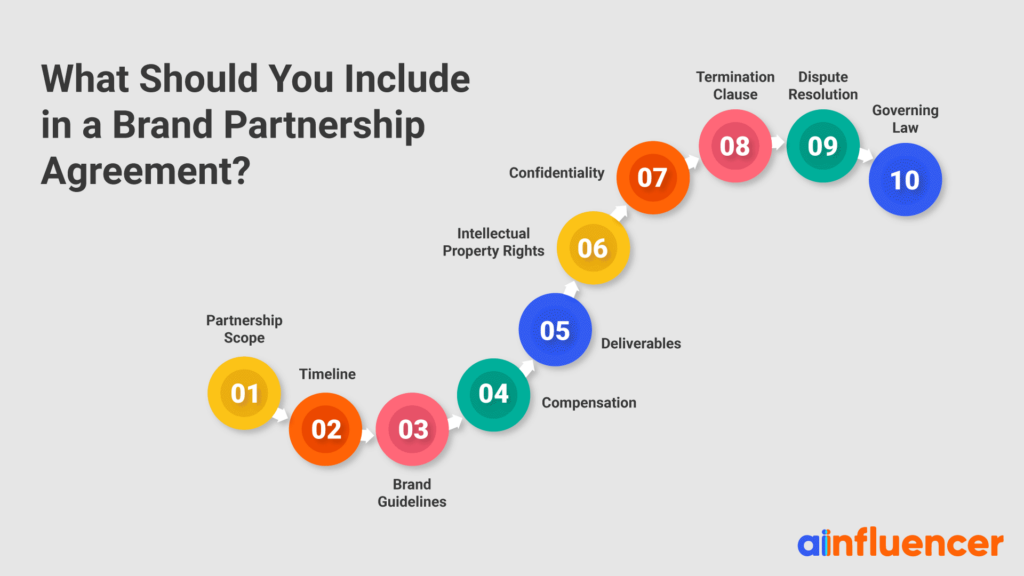Collaborating with other brands can be a great way to expand your reach and create unique content, but it’s important to have a clear and effective brand partnership agreement in place to ensure the success of the collaboration.
In this article, we’ll take a closer look at the key elements of a business partnership agreement and provide tips on how to create an agreement that works for everyone involved. Whether you’re new to brand collaborations or looking to improve your current process, this guide will help you navigate the world of brand partnerships and set you up for success.
What is a brand partnership?
A brand partnership is a type of business relationship where two or more brands collaborate to achieve a common goal. This means that two or more businesses come together and agree on specific terms to work towards achieving mutual benefits. In a brand partnership, each company maintains its individual identity and strengths while working together in harmony.
A contract of partnership is essential when entering into a brand partnership as it outlines the terms, responsibilities, expectations, and limitations of each party involved. The contract ensures that both parties are aware of their obligations and can hold each other accountable for delivering on their commitments. It also helps to prevent misunderstandings and disagreements in the future by clearly stating what is expected from each party.
What is a business partnership Agreement?
A legal partnership agreement is a legal document that outlines the terms and conditions of a partnership between two or more individuals. The agreement is necessary to protect the interests of all parties involved in the partnership. It specifies each partner’s responsibilities, rights, and obligations.
The partnership agreement law varies by state, but it generally covers topics such as profit sharing, decision-making authority, contributions, and liability. The legal partnership agreement also includes provisions for dispute resolution and dissolution procedures in case one or more partners decide to leave the business or dissolve the partnership altogether.
Having a written legal partnership agreement can help prevent misunderstandings between partners down the road. It serves as a roadmap for how decisions are made, profits are shared, and liabilities are managed. With clearly defined expectations laid out from the start, there will be less likelihood of conflict arising between partners.
What Should You Include in a Brand Partnership Agreement?
When drafting your contract of partnership, be sure to include:

1- Partnership Scope
All partnership agreements should define the scope of the partnership and what each party is responsible for.
2- Timeline
Your agreement should specify the duration of the partnership, including the start and end dates.
3- Brand Guidelines
The agreement should outline the brand guidelines that both parties must follow to ensure brand consistency.
4- Compensation
The agreement should specify how the compensation will be determined, whether it’s a flat fee or a percentage of sales.
5- Deliverables
The agreement should specify what each party is expected to deliver, such as marketing materials or product samples.
6- Intellectual Property Rights
It should also address intellectual property rights, including who owns the intellectual property and how it can be used.
If you are yet to register your intellectual property rights, consider doing it before entering a partnership agreement. However, you will want to talk to an IP expert or lawyer to help you understand expenses involved in securing a trademark and how to navigate the process.
7- Confidentiality
The agreement should include a confidentiality clause to protect sensitive information.
8- Termination Clause
The agreement should include a termination clause outlining the conditions under which the partnership can be terminated.
9- Dispute Resolution
Your agreement should also specify the process for resolving any disputes that may arise during the partnership.
10- Governing Law
Additionally, the agreement should specify the governing law that will apply to the partnership.
Note: Influencer marketing has become a popular and effective way for brands to collaborate with influential individuals to promote their collaboration programs, products, or services.
If you are looking for a tool to take your influencer marketing campaign to the next level with ease, use Ainfluencer.
This DIY marketplace is the ultimate influencer marketplace for small to medium-sized businesses looking to create high-quality content and reach millions of potential customers through the influence of micro influencers on TikTok and Instagram.
With Ainfluencer, businesses can tap into the creativity and influence of micro influencers in different niches to boost brand awareness, drive sales, and establish themselves as leaders in their respective industries in an authentic, cost-efficient, and viral way.

The stages of a business partnership agreement
Legal partnership agreements typically go through several stages. These stages may vary depending on the specific needs of the partners and the type of business they are forming. Here are some common stages of a business partnership agreement:
1- Initial discussions
This stage involves the partners discussing the basic terms of the partnership, such as the business goals, ownership structure, and roles and responsibilities.
2- Drafting the agreement
Once the partners have agreed on the basic terms, they will need to draft a formal partnership agreement. This document will outline the rights and responsibilities of each partner, the ownership structure, the management structure, and other key details.
3- Negotiations and revisions
The partners may need to negotiate some of the terms in the agreement and revise the draft several times before they are both satisfied with the final version.
4- Signing the agreement
Once the partners are in agreement on the terms of the partnership, they will sign the partnership agreement.
5- Implementation
With the agreement in place, the partners can begin implementing their business plan, such as securing funding, setting up the business, and hiring employees.
6- Ongoing management and updates
The partnership agreement should be reviewed periodically to ensure it remains relevant to the needs of the partners and the business. The partners may need to update the agreement to reflect changes in the business or their personal circumstances.
4 Types Of Business Partnerships
There are four main types of business partnerships:
1- General Partnership
This is the most common type of partnership, where all partners share equal responsibility for the management and financial obligations of the business. Each partner has the authority to make decisions on behalf of the business, and profits are shared equally among the partners.
2- Limited Partnership
In a limited partnership, there are two types of partners: general partners and limited partners. General partners have unlimited liability and control the management of the business, while limited partners have limited liability and do not participate in the management of the business.
3- Limited Liability Partnership
In a limited liability partnership, all partners have limited liability, meaning they are not personally responsible for the debts or liabilities of the partnership. This type of partnership is typically used by professionals, such as lawyers and accountants.
4- Joint Venture
A joint venture is a partnership between two or more businesses for a specific project or purpose. Each business contributes resources and shares in the profits and losses of the venture. Joint ventures are often used for large construction projects or international business ventures.
Business partnership agreement mistakes to avoid
Unfortunately, many people get bogged down in details and make crucial startup mistakes while creating small business partnership agreements.
Here are some common mistakes to avoid:
- Failing to clearly define each partner’s roles and responsibilities
- Not outlining how profits and losses will be shared
- Neglecting to include provisions for dispute resolution
- Failing to include provisions for the dissolution of the partnership
- Using generic templates without customization
- Not seeking legal advice
- Not skipping key details
- Not having the agreement reviewed by the council
- Not amending the agreement later
Conclusion
In conclusion, a brand collaboration agreement is a crucial document that outlines the terms and conditions of a partnership between two or more brands. Creating a brand collaboration agreement requires careful consideration of various factors, including the scope of the collaboration, the responsibilities of each party, intellectual property rights, payment terms, and dispute resolution mechanisms.
To create an effective brand collaboration agreement, it’s essential to consult with legal professionals and ensure that all aspects of the partnership are clearly defined and agreed upon by all parties involved. By having a comprehensive agreement in place, brands can mitigate risks, protect their intellectual property, and ensure that the collaboration is a mutually beneficial and successful venture.
Remember, a brand collaboration agreement is a legal formality and a tool to build a solid foundation for a successful collaboration between two brands.
Meta: Learn what to include in a brand collaboration agreement to protect both parties and ensure a successful partnership.
FAQs
Here are the steps to write a collaboration agreement:
1- Identify the parties: Begin the agreement by clearly identifying each party involved in the collaboration.
2- Define the purpose of the collaboration: State the purpose of the collaboration and the specific goals each party aims to achieve.
3- Outline each party’s responsibilities: Describe the roles and responsibilities of each party involved in the collaboration. This may include obligations related to project management, funding, resources, and deliverables.
4- Discuss intellectual property rights: Clearly define the ownership of any intellectual property created or used during the collaboration. Specify how the parties will license and use the intellectual property.
5- Include confidentiality provisions: Address the confidentiality of any confidential information shared between the parties during the collaboration. Specify how confidential information will be protected and define the limitations on its use.
6- Include termination provisions: Specify the circumstances under which the collaboration can be terminated and how termination will be carried out. This may include clauses related to notice periods and the return of resources or intellectual property.
7- Address dispute resolution: Define the process for resolving any disputes that may arise during the collaboration. This may include mediation, arbitration, or litigation.
8- Specify the governing law: Identify the law that will govern the agreement and any disputes that may arise.
9- Sign the agreement: Have all parties sign and date the agreement to indicate their acceptance and commitment to the terms outlined in the agreement.
1- Purpose of the collaboration: Clearly state the purpose of the collaboration and the specific goals that the parties hope to achieve through the collaboration.
2- Roles and responsibilities: Define the roles and responsibilities of each party involved in the collaboration, including who will be responsible for what tasks and who will be accountable for achieving specific milestones.
3- Intellectual property rights: Specify who owns the intellectual property that may be created or used during the collaboration, including patents, copyrights, trademarks, trade secrets, and other proprietary information.
4- Confidentiality and non-disclosure: Include provisions that protect the confidentiality of any sensitive information shared during the collaboration and prevent any party from disclosing this information to third parties without the other party’s consent.
5- Termination and exit strategies: Describe the circumstances under which the collaboration can be terminated and the procedures for winding down the collaboration, including the disposition of any intellectual property and the handling of any financial obligations.
6- Financial arrangements: Specify how the parties will share any costs and profits associated with the collaboration, including any payment terms, reimbursement of expenses, and allocation of any revenue generated.
7- Dispute resolution: Outline the procedures for resolving any disputes that may arise during the course of the collaboration, including mediation, arbitration, or litigation.
8- Governing law: State which laws will govern the collaboration agreement, including any applicable state, federal, or international laws.
9- Signatures and date: The collaboration agreement should be signed by all parties involved and dated to indicate when the agreement was executed.






![Read more about the article 6 Top influencer marketing platforms in UK [2024 Update]](https://blog.ainfluencer.com/wp-content/uploads/2023/02/Top-Influencer-Marketing-Platforms-In-UK-300x182.png)


